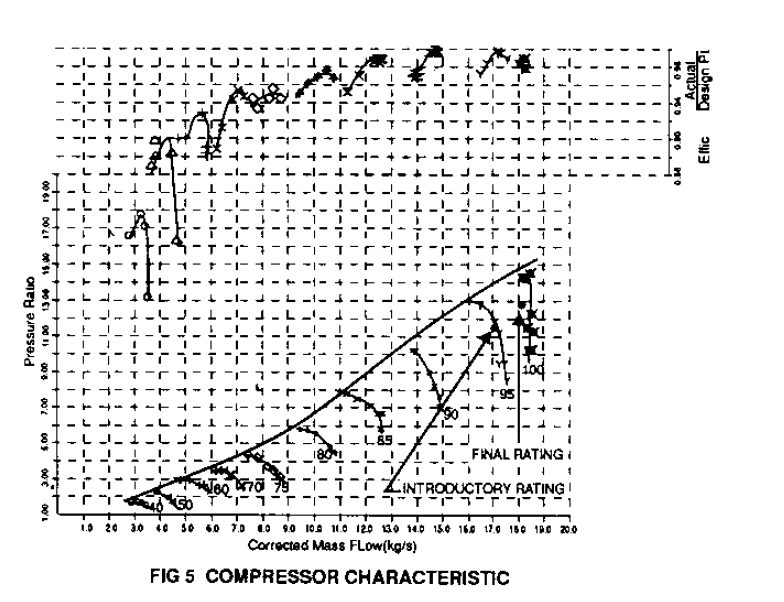RUSTON GAS TURBINE TB5000 TB5400 DEVELOPMENT
The pre-engine development programmes,
including compressor and turbine rigs, are
dealt with in Reference 1. This paper
concentrates on the engine development
programme.
Two dedicated test beds, at the Gas
Turbine Engineering Division (GTED) and a
further bed at the Ruston Works combined test
facility have been used for the development of
the Typhoon. The engines tested at GTED ran
coupled to a water brake and are fully data
logged to provide on-line data acquisition,
reduction and analysis. The water brake also
uses a digital control system which interfaces
with the turbine control module. This allows
loads to be changed via pre-programmed
routines allowing rapid transient simulations
to be carried out. The Ruston Works test bed
allows the full power generation package
including the generator to be tested. All the
development engines are dual fuel.
Three separate cores, with additional
modules and assemblies, have been used in the
development programme, each with the following
specific tasks:
CORE 1 BasicAerodynamic and
Thermodynamic Performance
(Prototype) ° Basic Mechanical Performance
° Blade Vibration Measurements
° Seal Systems Performance
CORE 2 0TurbineBidding Metal
Temperatures
Fully °CombustorTraverse Measurements
Instrumen- ° Structural Strain and
ted Temperature Measurements
Engine Compressorand Turbine
Performance
° Control System Development
° Start Optimisation
CORE 3 CyclicEndurance
Basic °Package&System Development
Produc- °ControlSystemOptimisation
tion Unit ° Emissions Measurements
The prototype Typhoon was delivered to the
Development Department on the 21st July, 1988.
The engine was then installed during the
remainder of July and August. The sequence of
events were then as follows:
1st September, 1988 - Engine Spun
2nd September, 1988 - Engine Fired
6th September, 1988 - Engine at Full Speed
29th September, 1988 - Full Load Achieved
During this early commissioning phase the
basic parameters of ignition, acceleration
rates, temperatures and pressures, rotor and
bearing performance were established. From the
early tests it was evident that the engine was
performing as designed.
The engine fired on the first attempt,
however, the light up was so gentle that the
rate of temperature rise was below that
expected by the controller. The development
of complicated equipment like a gas turbine
has in recent years benefitted enormously from
the digital controller and a simple keyboard
change to the ignition fuel setting quickly
allowed the engine to pull away.
The engine was observed to have a large
'light up window' on both fuels. The light up
window being defined as the minimum fuel
setting to ensure start reliability at all
ambients and engine temperature and the upper
boundary being defined by a heavy light with
the possibility of compressor stall and
overtemperature. Figure 4 shows a typical
light up window for liquid fuel. Light up on
gas fuel occurred almost at all angles.




Comments
Post a Comment